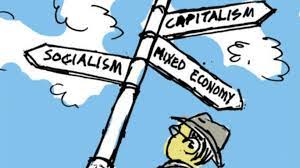There are several different types of economy depending on the ownership of the factors of production.

Types of Economy
- Market Economy: In a market economy, the allocation of resources is determined by supply and demand. Prices are set by the market and businesses are free to compete with one another to produce goods and services. Private individuals own the factors of production and make decisions about what to produce, how much to produce, and at what price to sell. The United States is often cited as an example of a market economy, where prices are set by supply and demand and private individuals own the factors of production.
- Command Economy: In a command economy, the government controls the allocation of resources and makes decisions about what goods and services should be produced, how much should be produced, and at what price they should be sold. The government owns the factors of production and there is no private ownership. North Korea is often cited as an example of a command economy, where the government controls the allocation of resources and makes decisions about what goods and services should be produced, how much should be produced, and at what price they should be sold.
- Mixed Economy: A mixed economy is a combination of both market and command economies. The government plays a role in regulating the economy and providing essential services, but private individuals and businesses still have a significant degree of economic freedom. Canada is often cited as an example of a mixed economy, where the government plays a role in regulating the economy and providing essential services, but private individuals and businesses still have a significant degree of economic freedom.
- Socialist Economy: In a socialist economy, the means of production are owned and controlled by the state, and economic decisions are made for the benefit of society as a whole. The government controls the allocation of resources and the distribution of goods and services. Cuba is often cited as an example of a socialist economy, where the means of production are owned and controlled by the state, and economic decisions are made for the benefit of society as a whole.
- Capitalist Economy: In a capitalist economy, the means of production are owned and controlled by private individuals, and the allocation of resources is determined by the laws of supply and demand. Economic decisions are made for the benefit of individuals and businesses rather than society as a whole. Hong Kong is often cited as an example of a capitalist economy, where the means of production are owned and controlled by private individuals, and the allocation of resources is determined by the laws of supply and demand. Economic decisions are made for the benefit of individuals and businesses rather than society as a whole.
Which type of Economy is followed in India?
India has a mixed economy, which combines elements of both market and command economies. While private individuals and businesses have a significant degree of economic freedom, the government also plays a role in regulating the economy and providing essential services.
The Indian government owns and controls certain industries such as railways, postal services, defense, and public utilities. The private sector, however, plays a major role in driving economic growth and development in industries such as manufacturing, services, and technology. Additionally, the government has implemented several policies aimed at promoting economic growth and development, such as foreign investment liberalization, industrial deregulation, and privatization.
Why India adopted Mixed Economy after Independence?
India adopted a mixed economy model after independence primarily because of the unique challenges faced by the country at that time. The Indian economy was characterized by widespread poverty, underdevelopment, and economic backwardness. The country had a large agrarian population with limited access to modern technology, education, and healthcare. The level of industrialization was low, and the country was heavily dependent on imports to meet its needs.
In this context, the government felt that a planned approach to economic development was necessary to address these challenges and achieve self-sufficiency. The mixed economy model was seen as a way to combine the benefits of both market and command economies, by allowing the private sector to play a role in driving economic growth and development, while also ensuring that the government had the necessary tools to regulate the economy and provide essential services.
The mixed economy model was also seen as a way to address the social and economic inequalities that existed in Indian society at that time. The government believed that by pursuing a policy of planned development, it could ensure that the benefits of economic growth and development were distributed more evenly across different sections of society.
Overall, the mixed economy model was seen as a pragmatic and balanced approach to economic development that was suited to the unique challenges and circumstances faced by India at that time.
